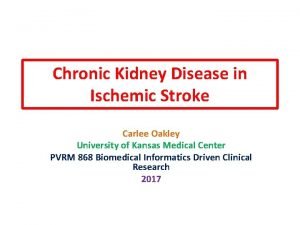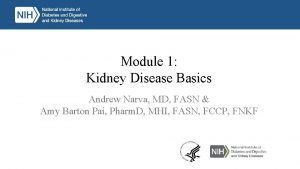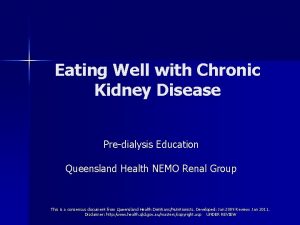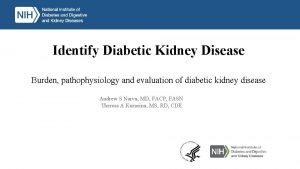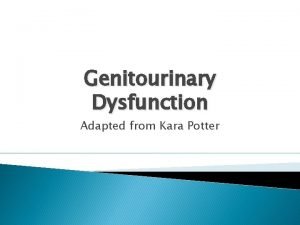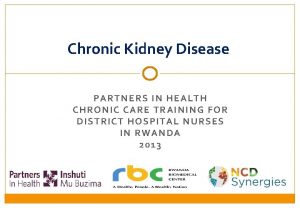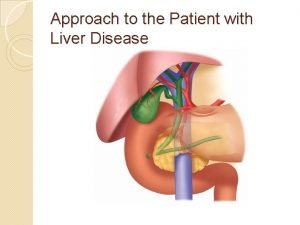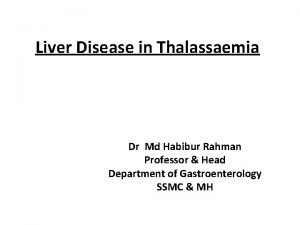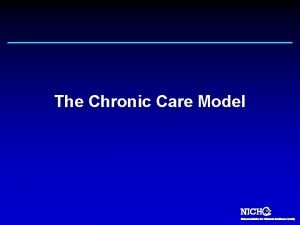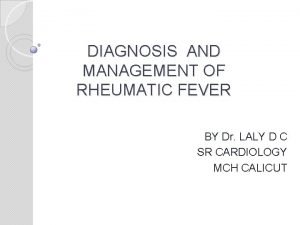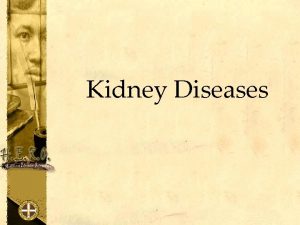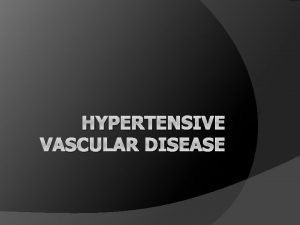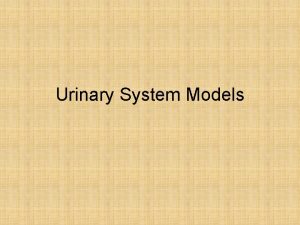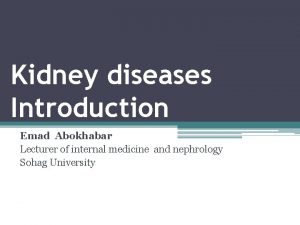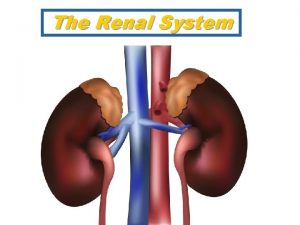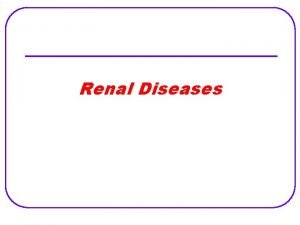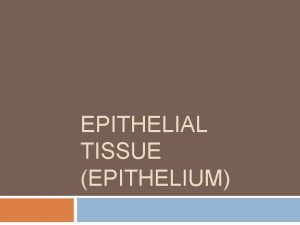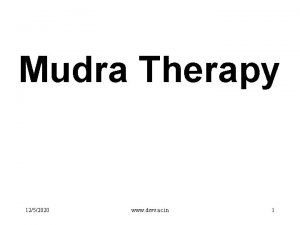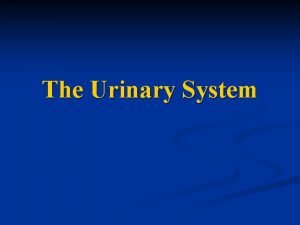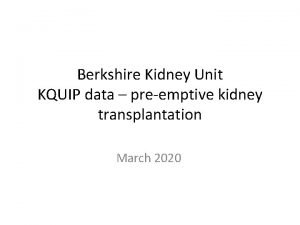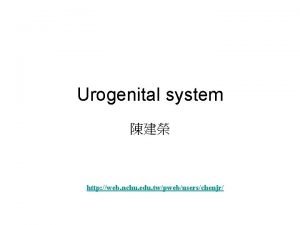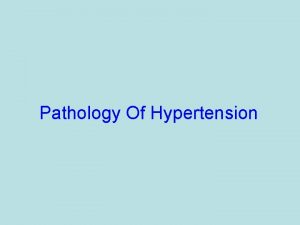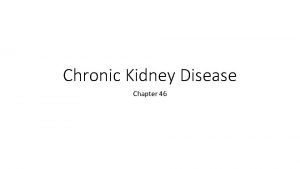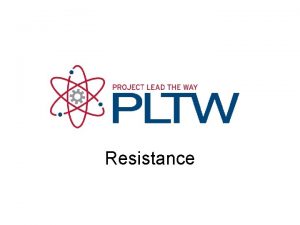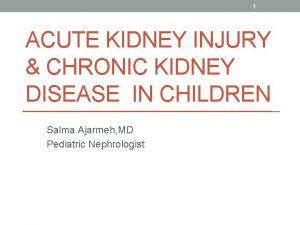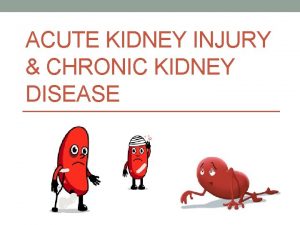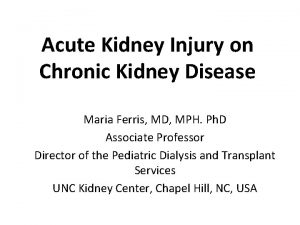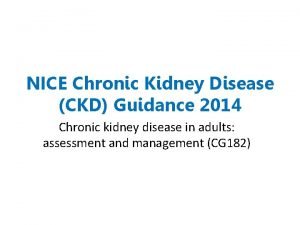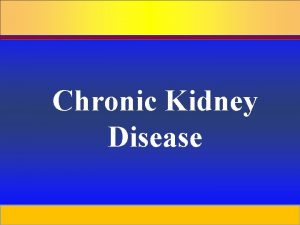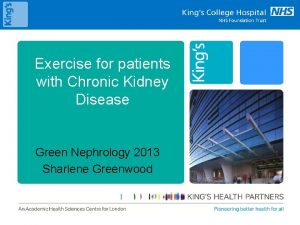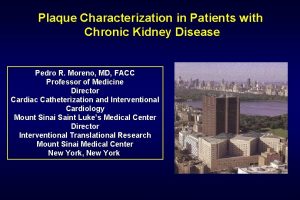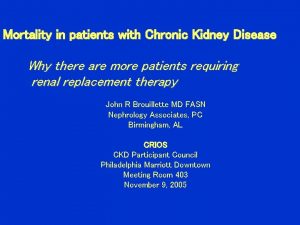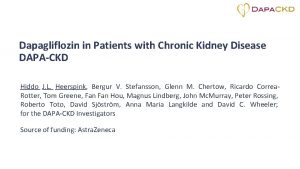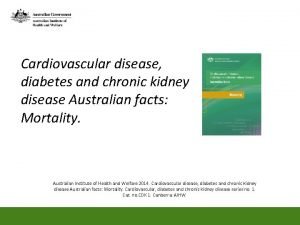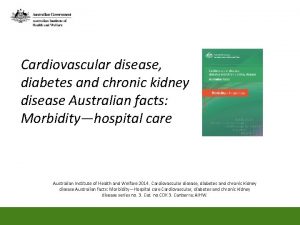Erythropoietin Resistance in Patients with Chronic Kidney Disease




















































- Slides: 52

Erythropoietin Resistance in Patients with Chronic Kidney Disease: Current Perspectives Dr Sima Abediazar Professor of Nephrology Tabriz university of medical science

ESA resistance or Hypo responsiveness • Occurs when the patient does not reach the desired serum hemoglobin (Hb) concentration even with the use of ESA at doses higher than usual or • when increasingly higher doses are necessary to maintain the recommended Hb concentration.

Hypo responsiveness to erythropoietin can be defined as: According to NKF-KDOQI guidelines: The presence of at least one of the following three conditions: A major decrease in Hb level at a constant ESA dose A considerable increase in the ESA dose requirement to maintain a given Hb level • A failure to achieve or maintain a desired Hb concentration using a maximum dose of 450 units/kg per week intravenous erythropoietin or 300 units/kg per week subcutaneous erythropoietin. • 45, 000 units/week of epoetin corresponds roughly to 100 mcg/week of darbepoetin

Hypo responsiveness to erythropoietin can be defined as: KDIGO defines: Initial hyporesponsiveness as having no increase in hemoglobin concentration after the first month of appropriate weight-based dosing. Acquired hyporesponsiveness as requiring two increases in ESA doses up to 50 percent beyond the dose at which the patient had originally been stable.

Hypo responsiveness to erythropoietin can be defined as: European best practice guidelines (EBPG): The resistance to ESAs is defined as a failure to achieve target Hb levels (11– 12 g/dl) with doses lower than 300 IU/kg/ week of epoetin or 1. 5 μg/kg/ week of darbopoietin-α.

Hypo responsiveness to erythropoietin can be defined as: The ESA Resistance Index (ERI) defined as: • The weekly weight-adjusted ESA dose (U/kg/week) divided by hemoglobin level (g/dl). • By means of the ERI values (baseline data), patients were divided into quartiles: • The cut-off values were: 1) Quartile 1 < 4. 19 2) Quartile 2 (4. 20 – 6. 64) 3) Quartile 3 (6. 65 – 10. 11) 4) Quartile 4 > 10. 11 Patients in the upper quartile were defined as ESA resistant.

Resistance to rh. EPO can be experienced as: • Acute • Short term episodes • longer, more chronic episodes. . 4 months of continuous rh. EPO hyporesponsiveness can be used to differentiate acute from chronic rh. EPO hyporesponsiveness Kidney International Reports (2018) 3, 841– 850

Why this is important? • Resistance to EPO increases the risk of death in patients with CKD owing to its association with increased blood pressure (increased cardiovascular risk), increased blood viscosity (endothelial stress), and improved platelet function (prothrombotic effect). • Therefore, identification of the factors that modify the response to the use of this class of drugs and development of strategies to optimize the benefits of treating anemia are essential.

EPIDEMIOLOGY • 12. 5 percent of hemodialysis patients • On peritoneal dialysis is likely much less common than among hemodialysis

CAUSES §Iron deficiency §Infection or inflammation §Inadequate dialysis §Severe hyperparathyroidism §bone aluminum accumulation (now very rare) § malignancy §bone marrow disorders such as myelodysplastic syndrome and multiple myeloma §hemoglobinopathies, such as sickle cell disease. § B 12 and folate deficiencies §Pure red cell aplasia §Malnutrition § drugs such as renin‑angiotensin‑aldosterone system blockers (RAAS blockers)

Menoufia Medical Journal, Volume 33 | Number 1 | January-March 2020 As Hb response is not included in this definition, various studies assessed ESA hyporesponsiveness by using ESA hyporesponsiveness index (EHRI). EHRI is calculated by dividing weekly ESA dose per kilogram of body weight (IU/kg/W) by Hb level (g/dl). EHRI is an easily calculated index that has direct relation with mortality in dialysis patients.

Menoufia Medical Journal, Volume 33 | Number 1 | January-March 2020 • Angiotensin converting enzyme (ACE) inhibitors/Angiotensin Receptor Blockers (ARBs) inhibit erythropoiesis induced by Recombinant Human Erythropoietin (r. Hu. EPO) in ESRD patients. • simultaneous use of ACE inhibitors/ARBs and r. Hu. EPO should be carried out with caution. • Inhibition of renin angiotensin system inhibits erythropoiesis by decreasing angiotensin II availability, which is a growth factor for erythrocytes. • Moreover, RAAS blockers can lead to an elevated level of negative regulator of erythropoiesis of acetyl‑seryl‑aspartyl‑lysyl‑proline (Ac. SDKP)

Iron Deficiency ESA Response Conditioning Factors and Optimization Strategies • This may be due to a true paucity of iron stores (absolute iron deficiency) or a relative (functional) deficiency, which prevents the use of available iron stores. • Several risk factors contribute to absolute and functional iron deficiency in CKD, including blood losses, impaired iron absorption, and chronic inflammation.

ESA Response Conditioning Factors and Optimization Strategies Iron Deficiency • Clinical practice guidelines recommend that oral iron will, in general, be sufficient to maintain and may be sufficient to attain the Hb within targets in ESA treated CKD patients not yet requiring dialysis and in those on peritoneal dialysis. • IN patients with resistance to ESA therapy on oral iron, or intolerant to oral iron, a therapeutic trial of IV iron trial seems reasonable. In contrast, most hemodialysis (HD) patients with iron deficiency will require IV iron.

Patients with CKD are at substantial risk of malnutrition, characterized by loss of protein energy (state of decreased body protein and energy fuel reserves). Nutritional Status Their nutritional status is affected by • general decrease in nutrient intake, • dietary restrictions, • intestinal malabsorption, • inflammatory state, • metabolic acidosis • dialysate losses (in dialysis patients). • These situations increase the risk for micronutrient deficiencies (folic acid, vitamin B 12, and iron) and can favor the onset of anemia.

Nutritional Status • Observational studies have shown that nutritional status is associated with EPO resistance in HD patients, mainly because of malnutrition-inflammation status • Such individuals receive tailored nutrition assessment and counseling to prevent and treat protein-energy wasting, mineral and electrolyte disorders, and other metabolic co-morbidities associated with CKD.

Secondary Hyperparathyroidism • Although CKD-MBD is the most widely recognized consequence of secondary hyperparathyroidism (HPTS) in these patients, consistent evidence shows that PTH and fibroblast growth factor 23 (FGF 23), both with markedly elevated levels in HPTS, have multiple adverse effects on extraskeletal tissues, including the pathological development of anemia.

Secondary Hyperparathyroidism • Excessive PTH secretion, which leads to bone marrow fibrosis and a consequent interference in erythropoiesis. • Thus, HPTS severity and expanded bone marrow fibrosis increase the EPO dose required to obtain an adequate response. • PTH is identified as a uremic toxin that suppresses endogenous EPO synthesis, inhibits bone marrow erythroid progenitors and decreases red cell survival. • High FGF 23 levels cause chronic inflammation, which can also contribute to anemia and EPO resistance in these patients.

Secondary Hyperparathyroidism • Thus, HPTS control should be considered a strategy for EPO resistance reversal. Several treatment options are available, including vitamin D receptor activators, cinacalcet hydrochloride, and parathyroidectomy. • However, the Mineral and Bone Disorders Outcomes Study for Japanese Chronic Kidney Disease Stage 5 D Patients, a multicenter prospective cohort study conducted with hemodialysis patients with HPTS, showed that the use of a calcimimetic drug promoted a relatively small increase in Hb level and that further investigations are needed to define the role of calcimimetic drugs to control anemia. 39 •

• The interaction of ESAs with antihypertensive drugs of the class of angiotensin-converting enzyme (ACE) inhibitors and angiotensin receptor blockers (ARB) can decrease the hematopoietic response to ESA. • Renin-angiotensin system inhibition decreases erythropoiesis, and ACE inhibition can lead to a high level of negative erythropoiesis regulation. • Currently, ACE gene polymorphisms are known to largely influence ACE serum activity. Thus, some patients may be more susceptible to ESA resistance when using ACE and ARB inhibitors. • The exclusion of these therapeutic classes for the treatment of arterial hypertension in these patients can be an interesting strategy to optimize the treatment of anemia. Drugs

Anti-erythropoietin antibody • Anti-erythropoietin antibody associated pure red cell aplasia (PRCA) is a very rare cause of resistance. • pure red cell aplasia (PRCA) due to antierythropoietin antibodies should be suspected in an individual who has previously responded to EPO if the Hb level declines by >2 g/l per month or the reticulocyte count is <20, 000/u. L. • Anti-erythropoietin receptor autoantibodies have been detected in some HD patients and their presence was an independent and significant factor of resistance to ESAs. • Therefore, after excluding the most frequent causes of EPO resistance, it is important to investigate the presence of anti-erythropoietin receptor autoantibodies in serum.

Inadequate dialysis • In dialysis patients, inadequate dialysis can cause ESA resistance. Adequacy has been linked to the use of lower ESA doses in patients with CKD. • HD session duration has also been related to EPO response. • A study conducted with 300 HD patients showed that the addition of 1 hour of treatment can reduce the EPO dose by approximately 2000 IU/week.

Chronic Inflammation • Most CKD patients present a chronic inflammatory state with increased levels of inflammatory markers, such as C-reactive protein (CRP), interleukin (IL) − 1, IL-6, Interferon-gamma (IFN-g), and tumor necrosis factor-alpha (TNF-α), and increasing prevalence is associated with decreased renal function. • Uremic syndrome, heart failure, persistent infections, biocompatibility of the dialyzer membrane, use of catheters, accumulation of advanced glycation products, and progressive decrease in the glomerular filtration rate (GFR) may contribute to the development of inflammation in CKD, with consequent production of inflammatory cytokines. • Cytokines have a direct effect on cell differentiation from the erythrocyte pathway and mediate the induction of apoptosis. They also interfere with the EPO-mediated signaling pathway, inhibiting

Chronic Inflammation • The responsiveness of erythrocytic progenitor cells to EPO appears to be inversely related to the severity of the chronic disease and the amount of circulating cytokines. The presence of high concentrations of IFN-g or TNF-α causes the need for higher amounts of EPO to restore the formation of erythrocyte colony forming units. • In HD patients, inflammation has been associated with EPO resistance mainly because the inflammatory state decreases the bone marrow response to ESA, changing iron regulation through hepcidin upregulation and/or causing red blood cell/erythrocyte hemolysis. 14 • Recently, the Dialysis Outcomes and Practice Patterns Study, a prospective cohort study conducted between 2009 and 2018, evaluated 12, 389 hemodialysis patients in 21 countries and reported that new inflammation, defined as an acute increase in C-reactive protein (CRP) level, decreased the Hb response to ESA treatment. Patients with increased CRP levels have rapidly decreased Hb levels and increased ESA doses, which result in an increase in the prevalence of ESA hyporesponsiveness

Chronic Inflammation • Thus, the measurement of circulating levels of immunoinflammatory mediators, as well as the investigation of polymorphisms of the genes that encode these immunoinflammatory mediators, show that patients with CKD present a pro-inflammatory state, according to the phenotype, which is more evident in the measure in which the kidney injury progresses to terminal stages. 27 • These evidences suggest that early recognition of inflammatory states can help identify the cause of EPO resistance and guide decisions on ESA and IV iron dose adjustments. In addition, frequent inflammation evaluation can help identify potential candidates for the use of new therapies for anemia that are less sensitive to the inflammatory state, such as hypoxia-induced prolyl hydroxylase inhibitors. 28

Chronic Inflammation • Hypoxia-inducible factor (HIF)-prolyl hydroxylase plays the central role in oxygen sensing. In the presence of sufficient oxygen, prolyl hydroxylases (PHDs) degrade HIF. When hypoxia is present, HIF is stabilized and promotes the transcription of many genes responsible for cellular protection against hypoxia, including erythropoietin. 1 • HIF-2 appears to play an important role in regulating erythropoietin production and activating iron metabolism. Currently, PHD inhibitors which stabilize HIF-α, are being studied for the potential treatment of anemia in patients with CKD. 1

Int. J. Mol. Sci. 2020, 21, 725 • poor responding to ESA may be associated with an enhanced inflammatory state with elevated levels of inflammatory markers, including C reactive protein (CRP), IL-1, IL-6, and TNF- in CKD patients [165 ]. • Cytokines may impair iron metabolism, which results in functional iron deficiency [38 ]. • They also directly influence different erythropoiesis stages and mediate apoptosis induction, which implies • that the cytokine-mediated pro-inflammatory signaling. • also affects EPO activity [166 ]. • Cytokines inhibit the expression and regulation of specific transcription factors that are involved in the control of erythrocyte differentiation [166 ].

Int. J. Mol. Sci. 2020, 21, 725 • Immune activation results in the production of TNF- and IFN- by T cells and TNF- and IL-6 by monocytes. • These pro-inflammatory cytokines were shown to hamper the proliferation of erythrocyte progenitor cells and to antagonize the antiapoptotic activities of EPO. • According to studies, the responsiveness of erythrocyte progenitor cells to EPO seems to be inversely correlated with CKD severity as well as the amount of circulating cytokines.

Int. J. Mol. Sci. 2020, 21, 725 • EPO requirement to restore the formation of erythrocyte colony-forming units is higher in the presence of elevated levels of IFN-gamma or TNF[6 ]. • The inflammatory state contributes to poor response to treatment with EPO which finally leads to cachexia, a higher percentage of patients with cardiovascular disease and reduced quality of life [167 , 168 ].

• Patients in whom levels of TNF- were 2 ng/ m. L and IL-6 were 40 ng/ m. L required much higher doses of epoetin than patients with lower levels of these cytokines (128 U/ kg/ week versus 57 U/ kg/ week; p = 0. 0024). • A negative correlation between IL-12 production and epoetin doses were observed (p = 0. 029). In turn, Bá rá ny et al. [169 ] found the relationship between serum C-reactive protein (s-CRP) and the dose of recombinant human EPO required to maintain hemoglobin levels. In their study, weekly EPO dose used in patients with s. CRP 20 mg/ L was, on average, 80% higher than in patients with s. CRP below that level.

• EPO doses and s. CRP inversely correlated with serum albumin and serum iron levels, • which imply that the key mechanism through which inflammatory cytokines hamper erythropoiesis is coupled to iron metabolism. • There is positive correlation between serum concentrations of hs-CRP, IL-6, and TNF - and both the required epoetin dose and an index of epoetin responsiveness

• Pentoxifylline, which is a nonselective phosphodiesterase inhibitor exhibiting anti-TNF alpha properties, has been shown to significantly inhibit hemoglobin within six months and reduced serum TNFconcentration in patients with erythropoietin resistant anemia. • Other studies have demonstrated that pentoxifylline decreased other inflammatory parameters, including hs. CRP, erythrocyte sedimentation rate (ESR), serum fibrinogen, and TNF- in patients of CKD

Pentoxifylline In a randomized study, Johnson et al. compared pentoxifylline, an anti-inflammatory drug, with placebo in patients with CKD stage 4 or 5 and rh. EPOhyporesponsive anemia. Pentoxifylline showed significant increase in Hgb concentration versus placebo.

SUMMARY AT A GLANCE The study included 1044 patients in Japan from J-DOPPS and found that the lowest and highest levels of serum FGF-23 were associated with increased odds of ESA- hyporesponsiveness in patients on maintenancehaemodialysis, though this did not reach statistical signifi- cance. Further study is needed to address the relationship between circulating FGF-23 and anaemia in dialysis patients.

• Our results demonstrated that age, URR, %IDWG, BMI, use of ARBs, and serum iron and albumin were independently associated with the ERI in hemodialysis patients. • We verified that low serum iron reserve, an inflammatory state, poor nutritional status, and continuous use of ARBs limit the efficacy of a. EPO treatment.


Kidney International Reports (2018) 3, 841– 850

Hypoxia-inducible factor (HIF)prolyl hydroxylas inhibitors (PHIs) • Are a new emerging class of investigational products to treat anemia of CKD. • These molecules stimulate erythropoiesis through inhibition of HIFprolyl hydroxylase domain enzymes. • HIF 1 seems to be an interesting target as it regulates renal EPO production and erythropoiesis.

hypoxia-inducible factor prolyl hydroxylase inhibitor (Hif 1 inhibitors) Including, Daprodustat, Vadustat and Roxadustat • Daprodustat(GSK 1278863) is a HIF-PHI that is currently being investigated as a treatment for anemia associated with CKD in both dialysis and nondialysis subjects. • Both preclinical and clinical data showed that daprodustat stimulates endogenous EPO production, resulting in increased erythropoiesis and elevated Hgb concentrations. • These increases in Hgb are achieved with peak EPO exposures that are substantially lower than those observed with an i. v. administration of rh. EPO

hypoxia-inducible factor prolyl hydroxylase inhibitor (Hif 1 inhibitors) • The results of phase 2 trials involving CKD patients indicate that roxadustat enhanced levels of endogenous erythropoietin to within or near the physiologic range, and also it increased hemoglobin levels and improved iron homeostasis. • A single-blind, placebo-controlled study of ND-CKD stage 3 or 4 patients randomized to receive four escalating doses (0. 7, 1. 0, 1. 5, 2. 0 mg/ kg) of roxadustat either twice or thrice weekly over 28 days demonstrated that this drug increased Hb in a dose-dependent manner

hypoxia-inducible factor prolyl hydroxylase inhibitor (Hif 1 inhibitors) • The results of phase 2 placebo-controlled studies in patients with CKD treated with vadadustat as well as placebo-controlled and dose-ranging study of daprodustat in CKD population have demonstrated that such treatment was associated with the increase in hemoglobin level and its maintaining

hypoxiainducible factor prolyl hydroxylase inhibitor (Hif 1 inhibitors)

hypoxia-inducible factor prolyl hydroxylase inhibitor (Hif 1 inhibitors) Vadadustat (AKB-6548) • has been shown to restore baseline e. EPO levels within 24 h following its oral administration [132 ]. • In a phase IIa, double-blind, placebo-controlled trial of CKD patients who were randomized to receive escalating doses (240, 370, 500, 630 mg) of vadadustat or placebo orally once daily for 6 weeks, vadadustat significantly enhanced Hb levels in a dose-dependent manner. • Moreover, it increased the total iron-binding capacity and decreased concentrations of ferritin and hepcidin

Inhibiting hepcidin production • Hepcidin, is a key regulator of circulating iron absorption, has been found to be involved in the etiology of anemia in CKD. • Its concentrations were demonstrated to be influenced by inflammation. • The fact that anemia develops in spite of elevated EPO levels in CKD suggests that peripheral resistance or hyporesponsiveness to EPO may be the factual reason for its occurrence • New therapies targeted at inhibiting hepcidin production are being investigated as potential anemia treatment.

Inhibiting hepcidin production • The administration of Atorvastatin to CKD was shown to significantly lower serum hepcidin levels and improved hematological parameters

Inhibiting hepcidin production • using human hepcidin (h. Hepc) knock-in mice as a model of inflammation-induced anemia showed that high-affnity antibodies specific for h. Hepc neutralized h. Hepc in vitro and in vivo and facilitated anemia treatment due to the fact that they enhanced the absorption of dietary iron and stimulated its mobilization from iron stores for use in erythropoiesis.

Anti-IL-6 antibodies Studies are performed to assess the efficacy and safety of anti-IL 6 antibodies such as Tocilizumab and IL-6 monoclonal antibodies such as sultuximab. The latter one has been shown to increase hemoglobin levels, however, at the same time, it enhanced the risk of infections

Activin type-II receptor (Act. RII) Ig. G-Fc fusion proteins • Activins are soluble ligands belonging to a large transforming growth factor- (TGF- ) family and their expression is observed in bone marrow cells, including erythroid cells. • They are involved in the proliferation and differentiation of embryonic/ hematopoietic stem and erythropoietic cells. • Increase red blood cell numbers and hemoglobin levels in humans.

Activin type-II receptor (Act. RII) Ig. G-Fc fusion proteins Including sotatercept and luspatercept Sotatercept: Is a fusion protein comprising of an extracellular chain of activin receptor IIA and the Fc domain of human Ig. G 1. It inhibits the activation of endogenic, membranous receptors (Act. RIIA) of activin by binding circulating activin and related proteins (e. g. , BMP 10 and BMP 11).

Activin type-II receptor (Act. RII) Ig. G-Fc fusion proteins Sotatercept • Stimulates the release of the mature erythrocyte forms, • Decreases the expression of the vascular endothelial growth factor (VEGF), which is an inhibitor of erythropoiesis • Inhibits hepcidin transcription in the liver. • The results of preliminary studies with sotatercept in dialysis patients have demonstrated a dosedependent increase in Hb and a decrease in extraosseous calcification. • Moreover, it influences the expression of angiotensin II which can promote erythropoiesis directly and indirectly via EPO production.

Activin type-II receptor (Act. RII) Ig. G-Fc fusion proteins Luspatercept • Luspatercept ACE-536; Acceleron/ Celgene Corp) is another ligand-trapping fusion protein that contains the extracellular domain of human activin receptor type IIB (ACTRIIB) modified to diminish activin binding. • It has been shown to exert erythropoietic activity and stimulate the maturation of late-stage erythroid precursors in vivo. • The treatment with EPO and luspatercept provides a synergistic erythropoietic response. • In a phase 1, randomized, double-blind, placebo-controlled, clinical trial of ACE-536, it increased Hb levels in a dose-dependent mode 7 days after treatment initiation, and this effect was maintained for several weeks following treatment in postmenopausal women.

Positive results on decreased ESA resistance with the use of ESA Adjuvant Therapies Adjuvant therapies aimed at optimizing ESA response may be a promising strategy in the treatment of anemia in patients with CKD. • L-carnitine • ascorbic acid • vitamin • statins • zinc • and ferric citrate current international guidelines do not recommend adjuvant therapies, and iron, folic acid and vitamin B 12 supplementation is only recommended when the need is diagnosed and not as a routine prescription for ESA optimization.
 Nephrology near atwater
Nephrology near atwater Nih score
Nih score Stimuli for erythropoiesis
Stimuli for erythropoiesis Albumin kidney disease
Albumin kidney disease Nemo kidney disease
Nemo kidney disease Albumin kidney disease
Albumin kidney disease Sighns of kidney problems
Sighns of kidney problems Symptomatic polycystic kidney disease
Symptomatic polycystic kidney disease Choronic kidney disease
Choronic kidney disease Peripheral stigmata of cld
Peripheral stigmata of cld Compensated cirrhosis
Compensated cirrhosis Stigmata of chronic liver disease
Stigmata of chronic liver disease Kate lorig chronic disease self-management
Kate lorig chronic disease self-management Stigmata of chronic liver disease
Stigmata of chronic liver disease Chronic disease
Chronic disease Jewish chronic disease hospital study pdf
Jewish chronic disease hospital study pdf Developedbyed
Developedbyed Dohányos tüdő
Dohányos tüdő Chronic liver stigmata
Chronic liver stigmata Chronic disease
Chronic disease Chronic granulomatous disease
Chronic granulomatous disease Chronic rheumatic heart disease
Chronic rheumatic heart disease Constant rate filtration equation
Constant rate filtration equation Friction and air resistance
Friction and air resistance Plant breeding for disease resistance
Plant breeding for disease resistance Communicable disease and non communicable disease
Communicable disease and non communicable disease Pictures of white particles in urine
Pictures of white particles in urine Nursing management of hydronephrosis
Nursing management of hydronephrosis Kidney
Kidney Flea bitten kidney
Flea bitten kidney Minor calyx
Minor calyx Fish kidney
Fish kidney Nucleus
Nucleus Slk criteria
Slk criteria I am happy
I am happy Kidney biopsy core curriculum
Kidney biopsy core curriculum Kidney in human body
Kidney in human body Chapter 15 the urinary system figure 15-3
Chapter 15 the urinary system figure 15-3 The functional unit of the kidney is the .
The functional unit of the kidney is the . Peritubular capillaries
Peritubular capillaries Malpighian body
Malpighian body Corpusculum renale
Corpusculum renale Kidney epithelial tissue
Kidney epithelial tissue Kidney
Kidney Www.dsvv.ac.in
Www.dsvv.ac.in Coverings of kidney
Coverings of kidney Lung tissue
Lung tissue Kidney infection
Kidney infection Save kidney
Save kidney Macula densa function
Macula densa function Kidney
Kidney Fopamin
Fopamin Kidney
Kidney

